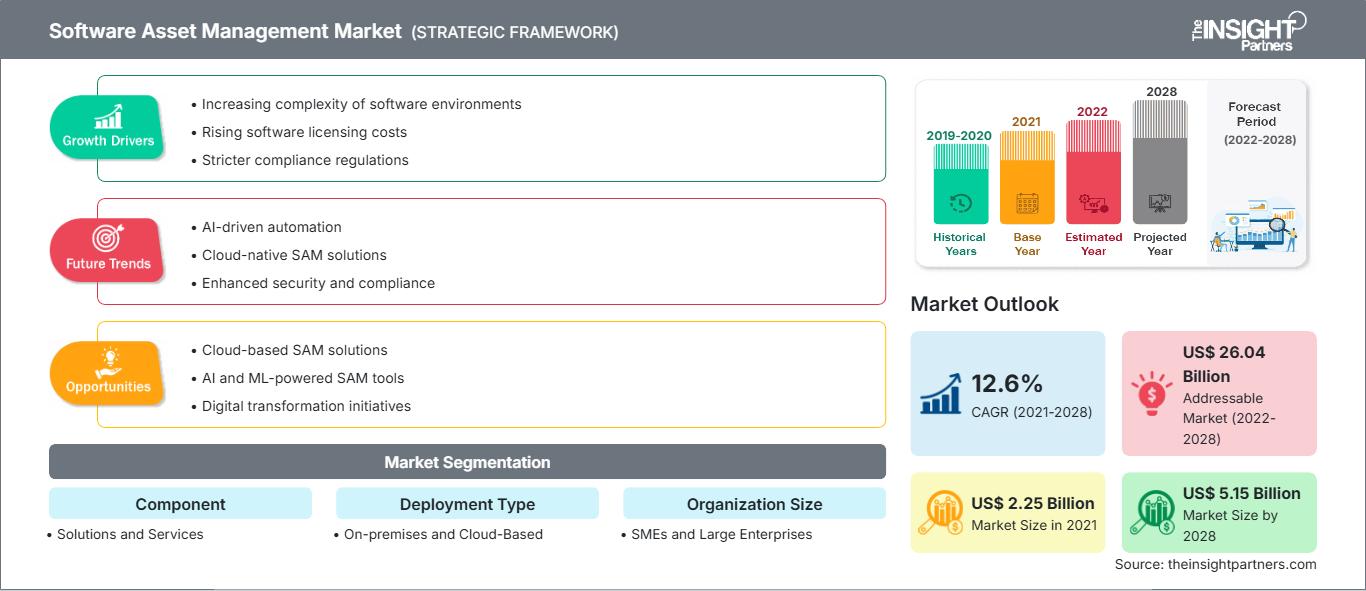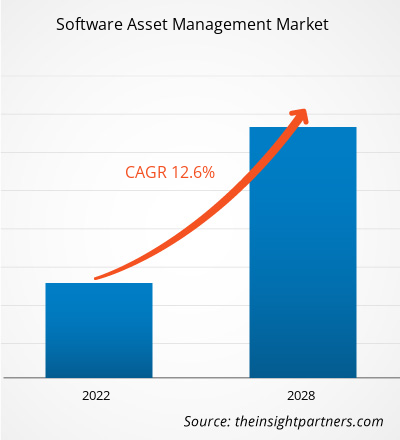[Rapporto di ricerca]Si prevede che il mercato della gestione delle risorse software crescerà da 2.250,37 milioni di dollari nel 2021 a 5.150,51 milioni di dollari entro il 2028; si stima una crescita a un CAGR del 12,6% dal 2021 al 2028.
L'amministrazione di sistemi, regole e procedure che consentono l'acquisizione, l'implementazione, l'utilizzo, la manutenzione e lo smaltimento di applicazioni software all'interno di un'organizzazione è nota come gestione delle risorse software (SAM). Il mercato della gestione delle risorse software è una componente della gestione delle risorse IT che mira a garantire che l'azienda rispetti i contratti di licenza e non spenda troppo per il software. L'identificazione delle risorse software, la validità dei contratti di licenza con l'utente finale (EULA) e l'uso appropriato del software libero sono tutti obiettivi cruciali di qualsiasi iniziativa SAM. La documentazione SAM può proteggere un'azienda da cause legali antipirateria, ridurre al minimo l'uso improprio involontario delle licenze e fornire il controllo sul software ombra in rete.
La gestione delle risorse software in una grande organizzazione può essere così complicata da richiedere lo sviluppo e la manutenzione di un database che conservi informazioni su acquisti, abbonamenti, licenze e patch di software. Un team di questo tipo è spesso responsabile del rinnovo delle licenze software, della negoziazione di nuovi contratti di licenza e dell'individuazione e rimozione di software raramente o mai utilizzato. Il mercato della gestione delle risorse software verificherà il numero di licenze software acquistate e lo concilierà con il numero di licenze installate per automatizzare il modo in cui le informazioni vengono ottenute da numerose fonti di inventario mobili, desktop, data center e cloud. Gli strumenti SAM possono anche tenere traccia del numero di licenze rimanenti. Per contenere i costi, queste informazioni possono essere utilizzate per eliminare o riallocare il software non utilizzato.
Personalizza questo rapporto in base alle tue esigenze
Potrai personalizzare gratuitamente qualsiasi rapporto, comprese parti di questo rapporto, o analisi a livello di paese, pacchetto dati Excel, oltre a usufruire di grandi offerte e sconti per start-up e università
Mercato della gestione delle risorse software: Approfondimenti strategici

-
Ottieni le principali tendenze chiave del mercato di questo rapporto.Questo campione GRATUITO includerà l'analisi dei dati, che vanno dalle tendenze di mercato alle stime e alle previsioni.
Impatto della pandemia di COVID-19 sul mercato della gestione degli asset software
La pandemia di COVID-19 ha avuto effetti positivi sul mercato della gestione degli asset software. Le aziende si trovano ad affrontare nuove sfide a causa della pandemia di COVID-19, come lo sviluppo di ambienti di lavoro da remoto. L'epidemia di COVID-19 ha evidenziato la necessità di adottare tecnologie digitali e di sfruttare il potenziale delle soluzioni e dei servizi di gestione degli asset software per ottimizzare licenze e costi e aumentare il ROI degli asset IT. Inoltre, l'arrivo della pandemia nel 2020 ha portato con sé una serie di sfide per le operazioni del mercato globale. Poiché le infrastrutture sanitarie delle economie sviluppate sono collassate a causa dell'aumento dei casi, l'emergenza sanitaria pubblica richiederà al governo e agli operatori del mercato di intervenire e contribuire alla ripresa delle operazioni e dei ricavi del mercato attraverso sforzi collaborativi di iniziative di ricerca e sviluppo intraprese per recuperare le perdite durante il periodo di previsione, che termina nel 2028. Inoltre, l'aumento degli investimenti fa ben sperare per il settore negli anni successivi.
Approfondimenti di mercato - Mercato della gestione degli asset software
La crescente necessità di gestione del ciclo di vita degli asset aumenta la domanda per il mercato della gestione degli asset software
Tutte le procedure e gli utenti dell'infrastruttura IT devono gestire, regolamentare e salvaguardare gli asset software dell'azienda durante il loro ciclo di vita. La gestione degli asset IT (ITAM), la gestione dei servizi IT (ITSM) e la gestione degli asset hardware (HAM) sono tutti sottoinsiemi della gestione degli asset software (SAM). L'ITAM mira a migliorare la gestione degli asset software e hardware, ottimizzando al contempo i risparmi sui costi e limitando i rischi di audit. Le aziende moderne considerano il software un elemento integrante delle loro operazioni quotidiane. In media, un'organizzazione impiega 288 applicazioni per supportare i dipendenti in diverse attività. Con l'implementazione di una efficace gestione del ciclo di vita degli asset, o Life Cycle Asset Management (LCAM), le aziende possono determinare quando un asset raggiungerà le massime prestazioni e per quanto tempo ancora potrà essere utilizzato dall'azienda. Ad esempio, Blissfully è un'applicazione di gestione degli asset software e di gestione del software come servizio (SaaS) che può aiutare a risparmiare denaro, gestire tutti i fornitori di software, migliorare la produttività e aumentare la sicurezza del sistema software. Pertanto, la crescente necessità di gestione del ciclo di vita degli asset aumenta la domanda per il mercato della gestione degli asset software.
Approfondimenti sui segmenti dei componenti: mercato della gestione degli asset software
In base ai componenti, il mercato della gestione degli asset software è segmentato in soluzioni e servizi. Le soluzioni di gestione degli asset software aiutano i responsabili delle operazioni dei data center a identificare, localizzare, visualizzare e gestire tutti gli asset e a pianificare la capacità per la crescita futura. L'implementazione di un programma di gestione degli asset software ha uno scopo tattico: Confrontare il numero di licenze software acquisite con il numero di licenze effettivamente consumate o utilizzate. Un programma di gestione delle risorse software efficace deve verificare che tutto il software installato venga utilizzato nel rispetto dei termini e delle condizioni del contratto di licenza del singolo fornitore e bilanciando il numero di licenze acquistate con la quantità consumata. In caso di audit da parte di un fornitore di software o di una terza parte come la Business Software Alliance (BSA), le aziende possono ridurre le responsabilità associate alla pirateria informatica.
Approfondimenti sul segmento di mercato del software asset management - Mercato del software asset management
In base al tipo di distribuzione, la gestione delle risorse software è suddivisa in on-premise e basata su cloud. Le soluzioni di gestione delle risorse software basate su cloud sono più pratiche da utilizzare su dispositivi con schermi di diverse dimensioni (desktop, laptop, tablet, dispositivi palmari e smartphone). Anche i dati provenienti da RFID, codici a barre e NFC possono essere salvati nel cloud, semplificandone il recupero. I sistemi basati su cloud sono ideali per audit multi-sede e per una combinazione di audit interni ed esterni delle risorse, grazie alla loro facilità di accesso. In genere, è più semplice caricare foto delle risorse e aggiungere commenti da più dispositivi. Una soluzione di gestione delle risorse software basata su cloud può facilitare facilmente il controllo delle versioni, l'audit e le catene di approvazione multipla.
Approfondimenti sui segmenti di tipo organizzativo
In base al tipo di organizzazione, il mercato della gestione delle risorse software può essere suddiviso in piccole e medie imprese e grandi imprese. Le grandi imprese possono effettuare ingenti investimenti in software di fascia alta per aumentare la produttività aziendale. Per le imprese più grandi sarà necessario uno strumento SAM. I processi manuali possono essere automatizzati, accelerati e migliorati utilizzando uno strumento di gestione delle risorse software. Inoltre, la gestione delle risorse software aiuta le organizzazioni di diversi settori verticali a migliorare efficacemente le prestazioni e l'agilità delle proprie risorse IT.
Approfondimenti sui segmenti verticali di settore: mercato della gestione delle risorse software
In base al settore verticale, il mercato della gestione delle risorse software è segmentato in pubblica amministrazione, commercio al dettaglio e beni di consumo, sanità e Scienze della vita, BFSI, media e intrattenimento, produzione, IT e telecomunicazioni e altri. Le tecnologie digitali stanno trasformando il modo in cui l'industria manifatturiera approccia il proprio business. Si stima che la tecnologia giocherà un ruolo fondamentale nell'Industria 4.0. La gestione delle risorse software sarà un elemento chiave di questa nuova era della produzione.
Gli operatori del mercato si concentrano su innovazioni e sviluppi di nuovi prodotti integrando tecnologie e funzionalità avanzate per competere. Snow Atlas è l'unica piattaforma integrata sviluppata da zero per aiutare le aziende a identificare, monitorare e ottimizzare i propri investimenti tecnologici, sia on-premise che nel cloud, secondo Snow Software, leader globale nell'intelligence tecnologica. Le integrazioni di gestione delle risorse software (SAM), gestione del software-as-a-service (SaaS) e gestione dei servizi IT (ITSM) fornite come servizio sono le prime soluzioni accessibili sulla nuova piattaforma cloud-native, presenti nelle soluzioni di gestione degli accessi al software.
In base ai componenti, il mercato della gestione delle risorse software è segmentato in soluzioni e servizi. In termini di tipo di implementazione, la gestione delle risorse software è suddivisa in on-premise e basata su cloud. In base al tipo di organizzazione, il mercato della gestione delle risorse software può essere suddiviso in piccole e medie imprese e grandi imprese. In base al settore verticale, il mercato della gestione delle risorse software è segmentato in pubblica amministrazione, commercio al dettaglio e beni di consumo, sanità e scienze biologiche, BFSI, media e intrattenimento, produzione, IT e telecomunicazioni e altri. In base alla regione, il mercato globale della gestione delle risorse software è segmentato in Nord America, Europa, Asia-Pacifico, Medio Oriente e Africa e Sud America.
Mercato della gestione delle risorse software
Le tendenze regionali e i fattori che influenzano il mercato del Software Asset Management durante il periodo di previsione sono stati ampiamente spiegati dagli analisti di The Insight Partners. Questa sezione illustra anche i segmenti e la geografia del mercato del Software Asset Management in Nord America, Europa, Asia-Pacifico, Medio Oriente e Africa, America Meridionale e Centrale.
Ambito del rapporto di mercato sulla gestione delle risorse software
| Attributo del rapporto | Dettagli |
|---|---|
| Dimensioni del mercato in 2021 | US$ 2.25 Billion |
| Dimensioni del mercato per 2028 | US$ 5.15 Billion |
| CAGR globale (2021 - 2028) | 12.6% |
| Dati storici | 2019-2020 |
| Periodo di previsione | 2022-2028 |
| Segmenti coperti |
By Componente
|
| Regioni e paesi coperti |
Nord America
|
| Leader di mercato e profili aziendali chiave |
|
Densità degli operatori del mercato della gestione delle risorse software: comprendere il suo impatto sulle dinamiche aziendali
Il mercato della gestione delle risorse software è in rapida crescita, trainato dalla crescente domanda degli utenti finali, dovuta a fattori quali l'evoluzione delle preferenze dei consumatori, i progressi tecnologici e una maggiore consapevolezza dei vantaggi del prodotto. Con l'aumento della domanda, le aziende stanno ampliando la propria offerta, innovando per soddisfare le esigenze dei consumatori e sfruttando le tendenze emergenti, alimentando ulteriormente la crescita del mercato.

- Ottieni il Mercato della gestione delle risorse software Panoramica dei principali attori chiave
Mercato della gestione delle risorse software - Profili aziendali
- Microsoft Corporation
- IVANTI
- SNOW SOFTWARE
- BMC SOFTWARE, INC.
- CERTERO
- FLEXERA
- IBM Corporation
- MICRO FOCUS
- SERVICENOW
- BROADCOM, INC.
- Analisi storica (2 anni), anno base, previsione (7 anni) con CAGR
- Analisi PEST e SWOT
- Valore/volume delle dimensioni del mercato - Globale, Regionale, Nazionale
- Industria e panorama competitivo
- Set di dati Excel
Report recenti
Rapporti correlati
Testimonianze
Motivo dell'acquisto
- Processo decisionale informato
- Comprensione delle dinamiche di mercato
- Analisi competitiva
- Analisi dei clienti
- Previsioni di mercato
- Mitigazione del rischio
- Pianificazione strategica
- Giustificazione degli investimenti
- Identificazione dei mercati emergenti
- Miglioramento delle strategie di marketing
- Aumento dell'efficienza operativa
- Allineamento alle tendenze normative






















 Ottieni un campione gratuito per - Mercato della gestione delle risorse software
Ottieni un campione gratuito per - Mercato della gestione delle risorse software